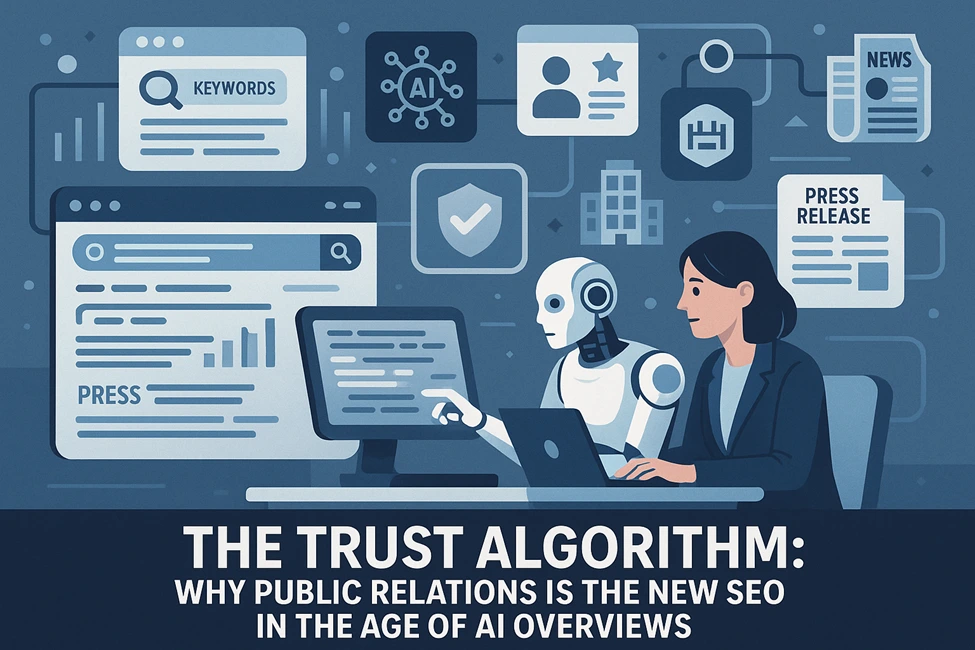The Trust Algorithm: Why Public Relations is the New SEO in the Age of AI Overviews

For years, the rules of the digital world were simple. If you wanted to be seen, you had to win the game of Google Search. The goal was clear: get your website to the top of the famous "ten blue links." Businesses in India and across the globe invested heavily in Search Engine Optimization (SEO), a technical race to climb the rankings. But that era is over.
The Google search page you knew is changing forever.
Today, when you search for something, you're increasingly likely to see a new feature at the very top: a detailed, AI-generated summary called an AI Overview. This isn't just another feature; it's a fundamental shift in how information is presented. The game is no longer about ranking first; it's about being authorized enough to be cited by the AI itself.
This new landscape is governed by what we at Public Media Solution call "The Trust Algorithm." It's an ecosystem where your digital visibility depends not on technical tricks, but on your real-world reputation, authority, and credibility. In this new era, the timeless principles of Public Relations (PR) have suddenly become the most potent and essential components of a successful SEO strategy. For us, this isn't a surprise. It's the moment technology has finally caught up to the integrated, reputation-first philosophy we've championed for years.
This article will break down precisely what this shift means for your business and why investing in your public reputation is the single most important thing you can do to secure your future online.
The Big Shift: What Are AI Overviews and Why Should You Care?
Imagine you ask a knowledgeable research assistant a question. Instead of giving you a list of books to read, they read everything for you, synthesize the most critical information, and give you a direct, comprehensive answer, pointing out the sources they used. That, in simple terms, is an AI Overview.
Google's AI now scans thousands of web pages to create these summaries, aiming to answer a user's question immediately, right on the results page. For users, this is incredibly helpful; in fact, 82% find AI-powered search more useful than the traditional format. But for businesses, it presents a massive challenge.
From Ranking to Retrieval: The New Goal of SEO
In the old model, if you ranked number one, you got the click. In the new model, the goal is to have your content retrieved by the AI and featured as a credible source within its summary. Your brand name and website link might appear as a citation, proving that your information was used to construct the answer.
Why is this a game-changer? Because many users will now get their answers without ever clicking on a single website. These are called "zero-click searches," and they are on the rise. If your brand isn't cited in that AI Overview, you are effectively invisible to a huge and growing segment of your audience. The fight is no longer to be at the top of the list; it's to be part of the answer itself.
The AI's Brain: How Does Google Decide Who to Trust?
To understand how to win in this new environment, you first need to understand how the AI thinks. Artificial intelligence isn't all-knowing. It's an information processor, and its biggest fear is being wrong or misleading. To avoid spreading misinformation—what experts call AI "hallucinations"—these systems are programmed to rely heavily on sources they deem credible and responsible.
Google uses a framework to measure this credibility, known as E-E-A-T.
E-E-A-T stands for Experience, Expertise, Authoritativeness, and Trustworthiness. Think of it as Google's checklist for vetting sources:
- Experience: Does the source have real, first-hand life experience with the topic? For example, a review of a restaurant from someone who has actually eaten there.
- Expertise: Does the author or website have proven knowledge and skill in the field? A financial advice article written by a certified financial planner holds more weight.
- Authoritativeness: Is the source a recognized leader in its industry? Are other experts and reputable sites referring to them?
- Trustworthiness: Is the information accurate, honest, and reliable? Can claims be verified?
When a user asks a question, the AI's algorithm scours the web and essentially asks, "Which sources demonstrate the best E-E-A-T on this topic?" The answer to that question determines whose content gets retrieved and whose gets ignored. This is where the world of Public Relations becomes your most valuable asset.
The Unbreakable Link: Where Public Relations and AI-Powered SEO Meet
For years, many businesses treated SEO and PR as individual departments. SEO was the technical team focused on keywords, while PR was the communications team focused on media relationships. In the age of AI, this siloed approach is a recipe for failure.
The activities that build a strong public reputation are the very same activities that generate the powerful E-E-A-T signals Google's AI is looking for. Let's connect the dots.
Building Authority Through Earned Media
In PR, "earned media" refers to getting your brand featured in reputable publications without paying for an advertisement. This includes news articles, magazine features, and interviews.
The SEO Connection: When a trusted, high-authority publication like The Economic Times, India Today, or Zee News writes about your company and links to your website, it sends a massive signal of authority to Google. This is no longer just a "backlink"; it's a public, third-party vote of confidence. The AI understands that if a respected news source trusts you, you are likely an authoritative figure in your industry. This is far more powerful than hundreds of low-quality links from unknown blogs.
Establishing Expertise with Thought Leadership
A core function of modern PR is establishing a company's executives as "thought leaders"—the go-to experts in their field. This is achieved through publishing insightful articles, giving interviews, and speaking at industry events.
The SEO Connection: When your CEO, like our own Ravinder Bharti, publishes an article in a major outlet like The Times of India, it creates a verifiable public record of their expertise. AI systems are smart enough to connect the dots. They see the expert author, the company they lead, and the topics they write about. This builds a web of credibility that promotes the perceived expertise of your entire brand, making your website's content more likely to be trusted and retrieved for relevant queries.
Proving Trustworthiness with Reputation Management
Effective PR isn't just about getting good press; it's also about managing your overall public perception. This includes promoting positive online reviews, responding to customer feedback, and navigating crises with transparent communication.
The SEO Connection: AI algorithms don't just count the number of stars in your Google reviews; they are increasingly capable of analyzing the sentiment of the text within those reviews, news articles, and social media conversations. A constant track record of positive customer experiences and a professionally managed online reputation are direct, measurable signals of trustworthiness. When an AI sees that the public always has good things to say about your brand, it learns that you are a reliable and trustworthy entity.
The Power of Awards and Recognition
Securing industry awards and accolades is another key pillar of a strong PR strategy. It provides objective, third-party validation of your company's excellence.
The SEO Connection: Awards, like our own "SEO Specialists of the Year" from APAC Insider or the "Corporate Excellence Award," are concrete, verifiable facts that an AI can easily process. They are undeniable proof points that distinguish you from your competitors. When an AI is deciding between two sources, the one with a cabinet full of industry awards is clearly demonstrating a higher level of authority and trustworthiness.
A Practical Guide: How to Build a PR-Led SEO Strategy for the AI Era
Understanding the approach is one thing; putting it into practice is another. Shifting to a PR-led SEO mindset requires a new set of actions. As a strategic partner to our clients, here is the framework we recommend.
Step 1: Audit Your Digital Reputation, Not Just Your Keywords
The old way was to obsess over keyword rankings. The new way is to start by asking, "What does the internet think of my brand?" Search for your company name, your products, and your CEO. What do the AI Overviews say? Are they positive, negative, or neutral? More importantly, are your competitors being cited for key industry topics where you are completely absent? This is the new competitive analysis, and it provides a clear roadmap of where your reputational gaps are.
Step 2: Create "Citation-Worthy" Content
Your website's content is no longer just a sales pitch for human visitors; it is now a primary data basis for training AI models. To be cited, your content must be structured, factual, and provide clear, direct answers to the questions your audience is asking. Think like a journalist or a researcher. Back up every claim with data, publish original insights, and create content that is so genuinely helpful that other websites and the AI itself will want to reference it. This is where professional content writing assistance, which focuses on creating unique, high-quality content, becomes indispensable.
Step 3: Pursue Strategic Media Placements
Stop chasing every possible backlink. Instead, focus your energy on securing meaningful media placements in high-authority publications that are genuinely respected in your industry. A single feature in a top-tier national newspaper or a maximum trade journal provides a more powerful authority signal than a hundred links from irrelevant websites. This is about quality, not quantity. It's about constructing a portfolio of credible mentions that prove your importance.
Step 4: Embrace the Human-AI Partnership
AI tools are potent for automating tasks like data research, keyword brainstorming, and generating first drafts of content. We use them every day. However, AI on its own has significant limitations. It lacks brand nuance, strategic thinking, genuine creativity, and an ethical compass. The true power lies in a symbiotic relationship: using AI for speed and scale, while relying on human specialists for strategy, oversight, and the creative spark that connects with an audience. This "human-in-the-loop" approach is essential, and it's the role a strategic partner like Public Media Solution is built to play.
The Public Media Solution Advantage: Why an Integrated Approach is No Longer Optional
The message is clear: in the new era of AI-driven search, a fragmented marketing strategy is doomed to fail. If your SEO team is in one corner chasing technical metrics and your PR team is in another corner focused only on media mentions, you are fighting with one hand tied behind your back.
Success now requires a holistic, integrated strategy where public relations, content marketing, and advanced SEO all work in concert toward a single, unified goal: building and broadcasting your brand's trust and authority.
At Public Media Solution, this integrated model is in our DNA. We've continuously operated as a "one-stop solution" and a "strategic partner," dedicated to helping our customers not just get clicks, but to "shape perceptions and influence conversations". We combine our award-winning PR expertise with data-driven digital marketing to build brand reputations that stand firm against the ever-changing tides of technology.
The rise of AI search hasn't changed our philosophy; it has validated it. The Trust Algorithm is here to stay.
Share
Table Of Contents
- The Big Shift: What Are AI Overviews and Why Should You Care?
- The AI's Brain: How Does Google Decide Who to Trust?
- The Unbreakable Link: Where Public Relations and AI-Powered SEO Meet
- A Practical Guide: How to Build a PR-Led SEO Strategy for the AI Era
- The Public Media Solution Advantage: Why an Integrated Approach is No Longer Optional
